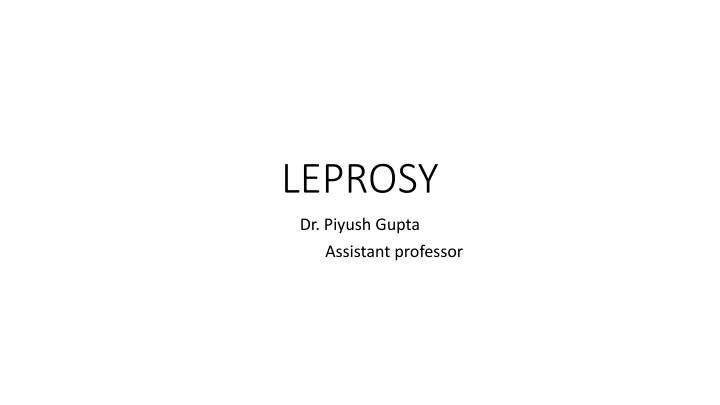
Epidemiological Determinants of Leprosy: Factors and Transmission
Explore the epidemiological determinants of leprosy including agent factors, host factors, inactivation of the disease, immunity, environmental factors, and modes of transmission. Learn about the infectious nature of leprosy, age-related incidence, treatment, and potential sources of infection.
Uploaded on | 1 Views
Download Presentation

Please find below an Image/Link to download the presentation.
The content on the website is provided AS IS for your information and personal use only. It may not be sold, licensed, or shared on other websites without obtaining consent from the author. If you encounter any issues during the download, it is possible that the publisher has removed the file from their server.
You are allowed to download the files provided on this website for personal or commercial use, subject to the condition that they are used lawfully. All files are the property of their respective owners.
The content on the website is provided AS IS for your information and personal use only. It may not be sold, licensed, or shared on other websites without obtaining consent from the author.
E N D
Presentation Transcript
LEPROSY Dr. Piyush Gupta Assistant professor
Epidemiological determinants of Leprosy- Agent factor , agent M. leprae. Source of infection- Multibacillary cases are most important source of infection in community. Infectivity Leprosy is highly infectious disease but of low pathogenicity. Attack rate 4.4 to 12 %
Host factor - Age- Infection can take place at any time depending upon the opportunities for exposure. The incidence case generally rise to a peak between 10 and 20 years of age than fall. Both incidence and prevalence of leprosy appears to be in male than in females in most region of world. Migration- In our country leprosy was considered to be mostly a rural problem.
Inactivation of disease- Where leprosy treatment facilities exist, inactivation or cure due to specific treatment is an important mode of elimination of cases from the prevalence pool. Even in the absence of specific treatment, a majority of patients, particularly of the tuberculoid and indeterminate types, tend to get cured spontaneously
It is a well-established fact that only a few persons exposed to infection develop the disease. A large proportion of early lesions that occur in leprosy heal spontaneously. Such abortive and self-healing lesions suggest immunity acquired through such lesions. Subclinical infections are far more common than was thought earlier; they are also believed to contribute to active immunity. A certain degree of immunity is also probable through infections with other related mycobacteria (15). It is now recognized that cell-mediated immunity (CMI) is responsible for resistance to infection with M. Jeprae
Environmental factors The risk of transmission is predominantly controlled by environmental factors: (a) the presence of infectious cases in that environment. There is evidence that humidity favours the survival of M. /eprae in the environment. M. /eprae can remain viable in dried nasal secretions for at least 9 days and in moist soil at room temperature for 46 days (b) overcrowding and lack of ventilation within households.
Mode of transmission- The mode of transmission of leprosy has not been established with certainty. The following theories are frequently debated : (A) DROPLET INFECTION : There is more and more evidence that leprosy may be transmitted via aerosols containing M. leprae (droplet infection). The possibility of this route of transmission is based on (a) the inability of the organisms to be found on the surface of the skin; (b) the demonstration of a large number of organisms in the nasal discharge; (c) the high proportion of morphologically intact bacilli in the nasal secretions; and (d) the evidence that M. leprae could survive outside the human host for several hours or days
B) CONTACT TRANSMISSION : Numerous studies indicate that leprosy is transmitted from person-to-person by close contact between an infectious patient and a healthy but susceptible person. This contact may be direct or indirect (e.g., contact with soil, and fomites such as contaminated clothes)
Incubation period -Leprosy has a long incubation period, an average of 3 to 5 years or more for lepromatous cases. The tuberculoid leprosy is thought to have a shorter incubation period. Symptoms can take as long as 20 years to appear recognize early symptoms or signs may contribute to an assumed prolonged incubation period in some patients.
Classification Leprosy is a disease bedevilled by classifications, e.g .. the Madrid classification, Ridley-Jopling classification, the Indian classification, etc. These classifications are based on clinical, bacteriological, immunological and histological status of patients. The Indian and Madrid classification systems are the most widely used in field leprosy programmes.they are not essentially different, as the following comparison shows
Indian classification- indeterminate type (early cases with one or two vague hypopigmented macules and definite sensory impairment.bacteriologically negative) tuberculoid type( one or two well-defined lesions, which may be flat or raised, hypopigmented or erythematous and are anaesthetic. The lesions are bacteriologically negative. ) borderline type ( those cases with four or more lesions which may be flat or raised, well or illdefined, hypopigmented or erythematous and show sensory impairment or loss. The bacteriological positivity of these lesions is variable.
lepromatous type ( those cases with diffuse infiltration or numerous flat or raised, poorly defined, shiny, smooth, symmetrically distributed lesions. These lesions are bacteriologically positive) pure neuritic type (those cases of leprosy which show nerve involvement but do not have any lesion in the skin. These cases are bacteriologically negative. )
Madrid classification- indeterminate tuberculoid:flat raised borderline lepromatous,
WHO classification- (1) Paucibacillary leprosy {1-5 skin lesions) (2) Multibacillary leprosy (more than six skin lesions).
Diagnosis- 1. CLINICAL EXAMINATION- includes detail history and examination ( clinical questions and related present complaints , past history ,any previous treatment , and Physical examination (i) A thorough inspection of the body surface (skin) to the extent permissible, in good natural light for the presence of suggestive, or tell tale evidence of leprosy. Palpation of the commonly involved peripheral and cutaneous nerves for the presence of thickening and/or tenderness. They are the ulnar nerve near the median epicondyle, greater auricular as it turns over the sternomastoid muscle, lateral popliteal and the dorsal branch of the radial.
Testing for loss of sensation for heat, cold, pain and light touch in the skin patches. It cannot be emphasized that not all the hypo pigmented patches show sensory impairment; (b) paresis or paralysis of the muscles of the hands and feet, leading to the disabilities or deformities.
Bacteriological examination- Skin smears are useful for diagnosing multibacillary leprosy and were originally used for distinguishing between paucibacillary and multibacillary leprosy.
LEPROSY CONTROL Ultimate prevention is achieved by breaking the chain of transmission. The three main goals of leprosy control are- (a) to interrupt transmission of the infection, thereby reduce the incidence of the disease so that it no longer constitutes a public health problem. (b) to treat patients in order to achieve their cure and where possible, complete rehabilitation. (c) to prevent the development of associated deformities.
LEPROSY CONTROL The introduction of multidrug therapy (MDT) has infused a new hope that the disease could be brought under effective control in the not too distant future. A revised strategy of leprosy control has emerged based on multidrug therapy. The following elements are considered as a minimum requirement for all leprosy control programmes : 1. Medical measures 2. Social support 3. Programme management 4. Evaluation
Medical measures - I. estimation of the problem II. early case detection Ill. multidrug therapy IV. surveillance V. immunoprophylaxis VI. chemoprophylaxis Vil. Deformities VIII. rehabilitation IX. health education
Estimation of problem -The first step in a leprosy control programme is to define the size of the problem or disease load in the community by means of epidemiological surveys. II. Early case detection -The aim of case detection is to identify and to register all cases of leprosy as soon as possible after they become evident.




